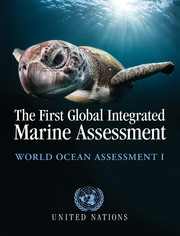Book contents
- Frontmatter
- Dedication
- Epigraph
- Contents
- Foreword and Preface
- Preface
- Summary of the first global integrated marine assessment
- The context of the assessment
- Assessment of Major Ecosystem Services from the Marine Environment (Other than Provisioning Services)
- Assessment of the Cross-cutting Issues: Food Security and Food Safety
- Assessment of Other Human Activities and the Marine Environment
- Assessment of Marine Biological Diversity and Habitats
- Section A Overview of Marine Biological Diversity
- Chapter 36 Overview of Marine Biological Diversity
- Division 36.A North Atlantic Ocean
- Division 36.B South Atlantic Ocean
- Division 36.C North Pacific Ocean
- Division 36.D South Pacific Ocean
- Division 36.E Indian Ocean
- Division 36.F Open Ocean Deep Sea
- Division 36.G Arctic Ocean
- Division 36.H Southern Ocean
- Section B Marine Ecosystems, Species and Habitats Scientifically Identified as Threatened, Declining or Otherwise in need of Special Attention or Protection
- I Marine Species
- II Marine Ecosystems and Habitats
- Section C Environmental, economic and/or social aspects of the conservation of marine species and habitats and capacity-building needs
- Overall Assessment
- Annexes
- References
Division 36.F - Open Ocean Deep Sea
from Chapter 36 - Overview of Marine Biological Diversity
Published online by Cambridge University Press: 18 May 2017
- Frontmatter
- Dedication
- Epigraph
- Contents
- Foreword and Preface
- Preface
- Summary of the first global integrated marine assessment
- The context of the assessment
- Assessment of Major Ecosystem Services from the Marine Environment (Other than Provisioning Services)
- Assessment of the Cross-cutting Issues: Food Security and Food Safety
- Assessment of Other Human Activities and the Marine Environment
- Assessment of Marine Biological Diversity and Habitats
- Section A Overview of Marine Biological Diversity
- Chapter 36 Overview of Marine Biological Diversity
- Division 36.A North Atlantic Ocean
- Division 36.B South Atlantic Ocean
- Division 36.C North Pacific Ocean
- Division 36.D South Pacific Ocean
- Division 36.E Indian Ocean
- Division 36.F Open Ocean Deep Sea
- Division 36.G Arctic Ocean
- Division 36.H Southern Ocean
- Section B Marine Ecosystems, Species and Habitats Scientifically Identified as Threatened, Declining or Otherwise in need of Special Attention or Protection
- I Marine Species
- II Marine Ecosystems and Habitats
- Section C Environmental, economic and/or social aspects of the conservation of marine species and habitats and capacity-building needs
- Overall Assessment
- Annexes
- References
Summary
Introduction to the open ocean deep sea
The deep sea comprises the seafloor, water column and biota therein below a specified depth contour. There are differences in views among experts and agencies regarding the appropriate depth to delineate the “deep sea”. This chapter uses a 200 metre depth contour as a starting point, so that the “deep sea” represents 63 per cent of the Earth's surface area and about 98.5 per cent of Earth's habitat volume (96.5 per cent of which is pelagic). However, much of the information presented in this chapter focuses on biodiversity of waters substantially deeper than 200 m. Many of the other regional divisions of Chapter 36 include treatments of shelf and slope biodiversity in continental-shelf and slope areas deeper than 200 m. Moreover Chapters 42 and 45 on cold water corals and vents and seeps, respectively, and 51 on canyons, seamounts and other specialized morphological habitat types address aspects of areas in greater detail. The estimates of global biodiversity of the deep sea in this chapter do include all biodiversity in waters and the seafloor below 200 m. However, in the other sections of this chapter redundancy with the other regional chapters is avoided, so that biodiversity of shelf, slope, reef, vents, and specialized habitats is assessed in the respective regional or thematic chapters.
This truly vast deep-sea realm constitutes the largest source of species and ecosystem diversity on Earth, with great potential for mineral, energy, and living resources (e.g., Koslow, 2007). Despite major technological advances and increased deep-sea exploration in the past few decades (Danovaro et al., 2014), a remarkably small portion of the deep sea has been investigated in detail (Ramirez-Llodra et al., 2010), particularly in terms of time-series research (Glover et al., 2010). For the pelagic areas much less than 0.0001 per cent of the over 1.3 billion km3 of deep water has been studied. The inevitable result is weaker characterization of deep-sea biodiversity compared to the shelf, slope and terrestrial realms. Correspondingly this also means that continued scientific and surveying efforts may potentially change our current understanding of deep-sea biodiversity.
- Type
- Chapter
- Information
- The First Global Integrated Marine AssessmentWorld Ocean Assessment I, pp. 685 - 704Publisher: Cambridge University PressPrint publication year: 2017

